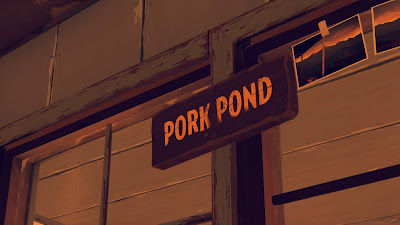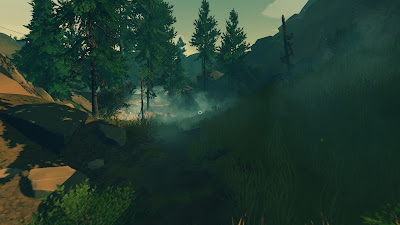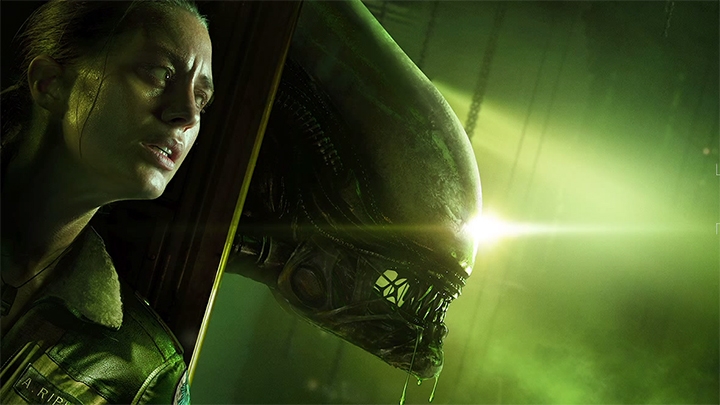Firewatch is a very pretty game that recaptures the charm of Gone Home, and also Kentucky Route Zero in its gameplay mechanics (walking around) and use of dialogue (the fact that your responses are remembered within each playthrough). It's a fun game that doesn't take itself too seriously, but quickly turns from self exploration towards am investigation of the national park, ending eventually with an escape from a bush fire (or forest fire).
In Firewatch there's a distinct break from the start of the game which introduces your character as either taking a break from responsibilities, or shirking them entirely - this allows for a certain degree of player control over how they view their character of Henry and his relationships. It takes a certain amount of scurrying to see how the dialogue choices effects on the narrative, it appears to be almost coincidental in presentation. Until Dawn provides a similar effect to this providing a narrative that is slightly affected, maybe a word or two more, upon choices the player made previously. Firewatch provides a lesser experiences of this, there's no choice that provides an easier means of escape or traversal just different reasons/causes for the same events.
 |
| These dialogue choices are largely presented on this screen. |
You left home to escape your wife.
Or,
You took a break from caring about your wife.
You pose Superman style for a picture.
Or,
You pose like one of her French girls for a picture.
 |
| This sign is alluded to earlier in the game. |
Incidental things which aren't necessary for the narrative to move on, but little things to make the game appear to be self aware. Firewatch presents these sections in a fairly prominent manner, leaving room for the knowledge that your choice is being reflected in the game - as opposed to the almost weaving nature of Kentucky Route Zero's meandering dialogue. It's an interesting implementation of player choice without changing the narrative too radically, but from its presentation there does not appear to be enough there to alter the narrative to any great deal. Which is understandable Firewatch is not one of those adventure games, it is one of those walking game Gone Home, Dear Esther, or Everyone Has Gone to Rapture. You exist in the world to see what happens, or what has happened, but you rarely affect it.
While these choices are presented giving a background to Henry, the game also introduces the main game mechanics walking, picking objects up and placing them, all of which seem to be getting Henry prepared for some sort of trip. From there the game jumps ahead into sections - from the carpark of an apartment complex, to the entrance of the Shoshone national park, to part way of the hike to , to finally the area in which you're firewatching, Two Pines lookout. You are pretty much restricted in what you can do, but the area that you explore is one that is a good introduction to the area. Eventually you make your way up to the Firetower set your pack down and answer your walkie talkie and meet Delilah. Who you answer one or two questions to, before heading off to sleep after a long hike - which can almost be considered a reference to the heavy exposition needed to get the character to Shoshone (something heavily read into it).
This sets up the rest of the game as waking up talking to Delilah and doing various national park duties, enjoying the serenity, and uncovering the history of who else has been in Shoshone park. It provides a nice bit of enjoyment for the most part, but then progresses a bit too quickly for the park to be truly enjoyed - or rather that's how it felt, it's hard to judge serenity in a game when you've got objectives to do. Which may be my criticism of the game in that it provides almost too much direction in what to do, and the speed in which you can do it instead of just sitting, thinking and seeing how the park works. There were a number of times I wanted to pause to look at this or that, but the sense of urgency presented in the game objectives meant that more often than not I'd be running around to specific points rather than meandering. Although this probably says more about myself than the insinuation of game objectives, the one chance to explore (as identified by Delilah) doesn't present itself again once the main "conspiracy" part of the game presents itself.
 |
| Nicely enough these pages changed with each day. |
This is somewhat countered by the Kodiak camera you get and are encouraged to take pictures with. At the end of the game it's revealed that you can mail order these photos for yourself - which is a nice piece of marketing/paratext/tie-in. Though this lost a bit of its overall charm as when I originally grabbed it I took scenic shots (which if I'm humble were great), but as the main plot progressed I started to take more shots of different sections as "evidence," as the game suggests you take some shots. Eventually when I ran out of film I just chose to take screenshots for my own enjoyment of the world. It seemed a bit counter intuitive to promote using the camera as something that was important to the plot and then not using it there. But I guess that's the difficulty of instituting free-play within a game system.
 |
| Case in point putting out fires. |
 |
| My Australian sensibilities were shocked that they didn't call this a dunnycan |
So Firewatch is an interesting game, that doesn't go too far with its strengths - the open world, the encouragement of serenity, the variance in dialogue, the conspiracy narrative - but far enough to make it novel and interesting. Other games individually make the most of these strengths, Far Cry 2 with it's open world (and depiction of serenity, wildlife and fires), Kentucky Route Zero in its variance of dialogue, Psychonauts in its conspiracy narrative/camping theme. But Firewatch manages to combine these elements into a single game. So if you're in the mood for being experimental, or finding a catchall mixup of the aforementioned games then go for it, otherwise if you're looking for something more specific then you might want to look elsewhere.







